<-- Back to Part 24: ROM and EPROM
Kaycomp
Last revision of this page: Jun 2, 2025
Shrouded in Mystery
There are four models of CP/M Kaypros that are somewhat mysterious. Mostly there are only old advertisements and there are virtually no offers on the second-hand market. These models were (most likely) never sold on the customer market.
- Kaycomp II - Osborne alike (Osb)
- Kaycomp II - Kaypro alike (Kay)
- Kaypro 5 - The Unknown
- Kaypro 10 - The Predecessor
The no. 1 was a demonstration model only, which has probably long since ended up in a dustbin. Who knows? No. 3, the Kaypro 5, has probably never seen the light of day in a customer's home because it was likely the prototype for the later Kaypro 10. No. 4 could have come onto the market because a real sales brochure exists for it. This brochure was offered on eBay years ago, I bought it, but the seller sent me the wrong one. He thought Kaypro 10 was Kaypro 10 and so he must have sent my brochure to another customer sometime before. What a hassle!
Rarity & Price
The rarity of an old computer is essentially determined by the number of items and the price by the buyer's desire. To own or not to own, that is the question here.
I don't have to say much about an Apple I (200 units were built). In 2021 a wodden Apple I was auctioned for half a million dollars (or more).
The few Kaycomp II (Osb) have probably long since arrived in computer heaven. But in my opinion, the Kaycomp II (Kay), this Kaypro model, definitely has a chance of being mentioned in the news in the (near or far) future. As things stand today (12/2024), there are only two (2) computers that have been proven to exist.
- Apple I: 200 (70 verified to exist)
- Kaycomp II (Osb): 10-20 (fair prototypes)
- Kaycomp II (Kay): 50 or 100 or 200 (2 are verified to exist)
Walter Salm states that there are a few hand-made prototypes known to exist back then! A few means three or more. David Kay confirmed this in principle in an e-mail. He can't remember the exact number, but it is definitely less than 10. [17]

In this context, a statement made by Andrew Kay in August 1989 is interesting:
We scrapped the first 20 chassis, moved the drives to one side, and the system worked just great. [19]
Conclusion: There must have been between 10 and 20 (scrapped) units of the Kaycomp II Osborne alike.
Non-Linear's timing was perfect. When Kaypro shipped its first product, in June, 1982, Osborne, unbeknownst to the rest of the world, was already on a self-destruct course. By the time the fiscal year ended, less than 3 months later, Non-Linear had shipped $2,084,745 worth of II's (at wholesale value). [6]
According to the San Diego Evening Tribune the production got under way June 15. [15]
For the year ended August 31, 1982, net sales of microcomputers [K II's] and electronic instruments were $2,084,745 and $3,366,887, respectively. [7]
Since the final price for the customer was $1,795, I calculated 3 sales figures:
- $2,084,745 / 1,800 $/unit = 1,158 units (min)
- $2,084,745 / 1,600 $/unit = 1,305 units
- $2,084,745 / 1,350 $/unit = 1,544 units (max)
The mean dealer discount of 25% (1,350 $/unit) I have determined from a dealers price list from 1985. In other words, the number of approx. 1,544 Kaypro II's were sold in the period from June 15 to August 31, 1982. This short min-max calculation narrows down the computers sold very well. A minimum of 1.158 but a maximum of 1.544.
You would get 1,700 units if the dealer discount were 32%. However, this discount was only available for purchases of more than $250,000, which would have been just under 140 computers. [20]
How many of these (max) 1,544 units were labelled Kaycomp? It is a fact that the items labeled Kaycomp were not allowed to be sold due to possible name conflicts. [8] However, it is also a fact that a certain number were produced and given away (or sold). How large was the Kaycomp production batch in the frist run? 50, 100, ...?
The next quote is the very first schedule plan I have. It is from May 13, 1982. Here is the talk of 100 (Kaycomp II?).
The schedule calls for 100 computers this month [May 1982], increasing to 800 per month by August and to 2,000 monthly by the end of the year. [14]
The next statement from Andrew Kay is from August 1989.
We started shipping in June. 200 units. 600 in July. 900 in August. August. 1250 in September. (I'll never forget these numbers.) [19]
This are in total 1,700 units for fiscal 1982. Nearly 160 units more than my calculation above.
I don't think it's likely that the serial numbering started at zero. My Kaycomp II has the serial number 2,767 and the mainboard was manufactured on 30 June 1982, i.e. two weeks after the official production launch. My Kaypro would therefore fall exactly in the period June 15 - August 31. How can it have the serial number 2,767 if only 1,544 were produced/sold during this period? Is 2,000 or 2,500 the first serial number?
Osborne Look-Alike
For more information see here: Kaycomp II - Osborne Look-Alike.
The following picture is dated 15 March 1982 and to my knowledge is the very first photo of the Kaycomp II, published four days before the West Coast Computer Faire 7.
The company plans to introduce this new portable computer at the Computer Faire in San Francisco on March 19th. Delivery is scheduled to begin in April. [18]
Have a closer look at the last sentence of the figure caption: "... in a fan-cooled metal cabinet ...". As history has shown, the Kaycomp or Kaypro II was ultimately not equipped with a fan. This came later with the 4/84.

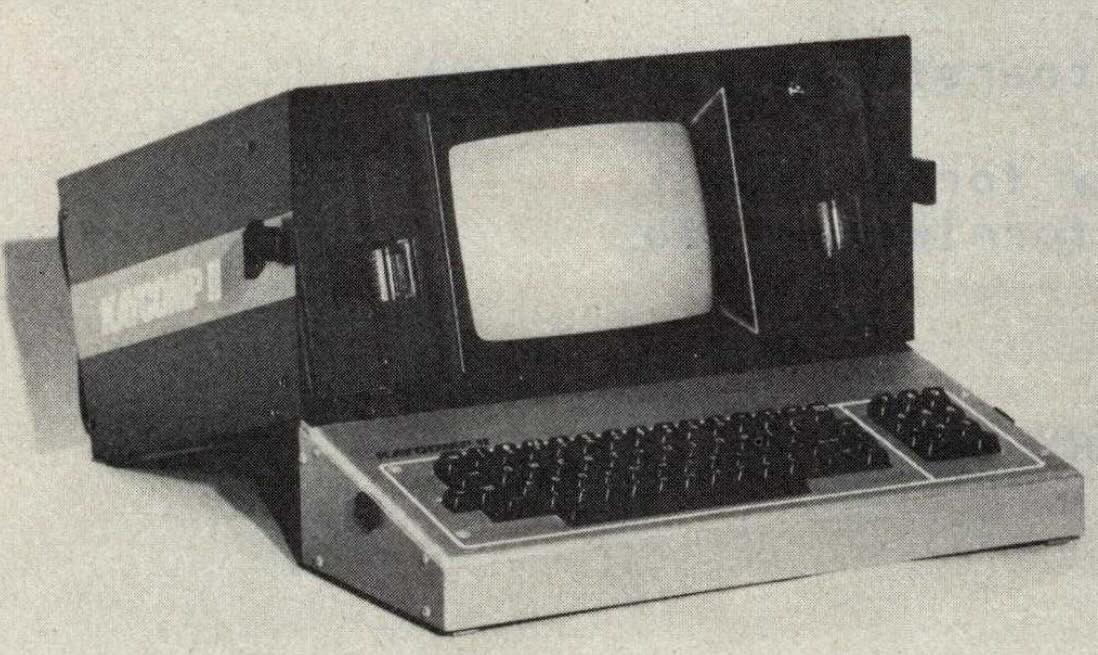
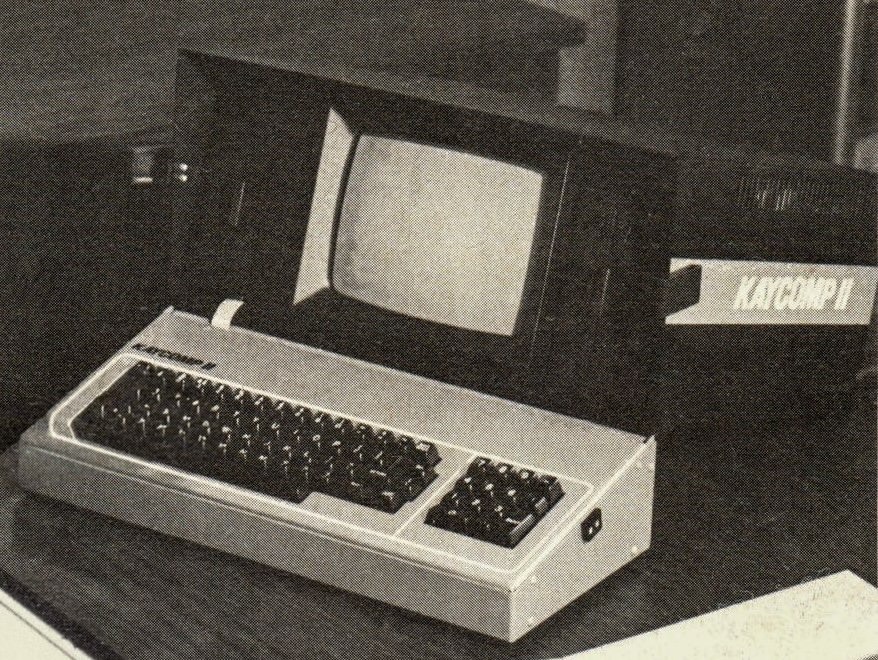
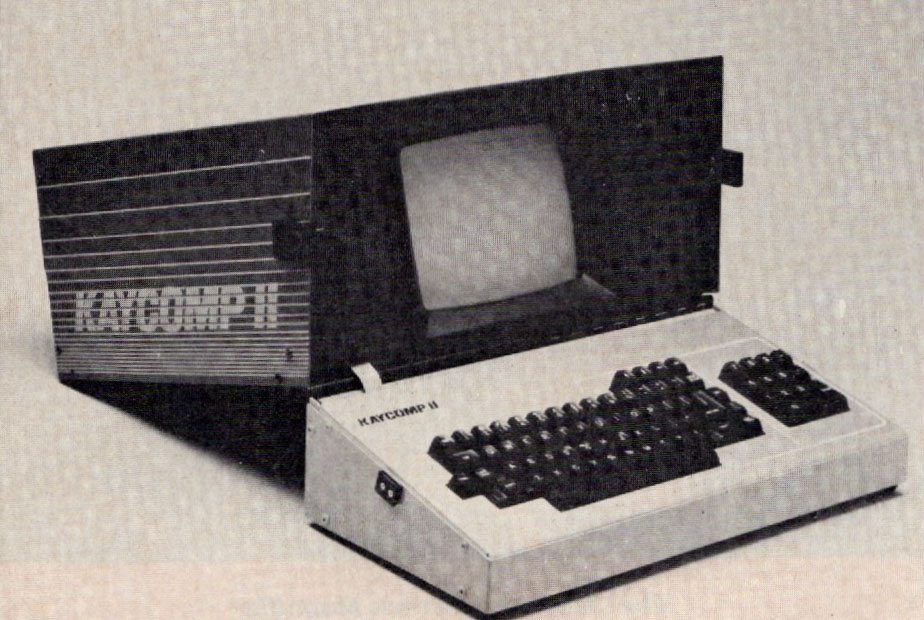
Side labeling: Kaycomp II
Back labeling: ?none
Housing variants: A, B
Keybord labeling: Kaycomp II
Keyboard variants: A, B, C
Brightness control: front
Floppy orientation: vertical, left & right
Floppy drives: full-high, single-sided, single-density
Floppy labeling: ?
Interfaces back: 1x serial
Mainboard: Fergusson Big Board I
Modem: no
Real Time Clock: no
Cooling fan: yes
Ventilation slots: left, none
Ventilation slots: right, yes
Ventilation slots: rear, ?
Mains cable: ?fixed
Mains switch: ?Alco MLSA206N
Company name (back) ?Non-Linear Systems
Dimensions: 18 x 8 x 15,5 inch
? = not verified due to no information/pictures
According to David, the Osborne alike Kaycomp II was just a prototype and was never sold. [3] Why? Read the story about the BigBoard I.
In contrast to the subsequent model, the prototype has no ventilation slots on the left side, but does have a fan. I don't know anything about the whereabouts of this prototype. During my video calls with David Kay, I unfortunately forgot to ask him about it.
Kaypro Look-Alike
The metal case was manufactured by Vista Industrial in Vista [16 miles from Del Mar], and [the colour scheme] was designed by Kay's daugther Janice, and her husband, Michael Batter, of the San Diego archtectural firm of Batter-Kay. [14]
Janice and Michael confirmed this to Frank Rahman during his visit in May 2025.
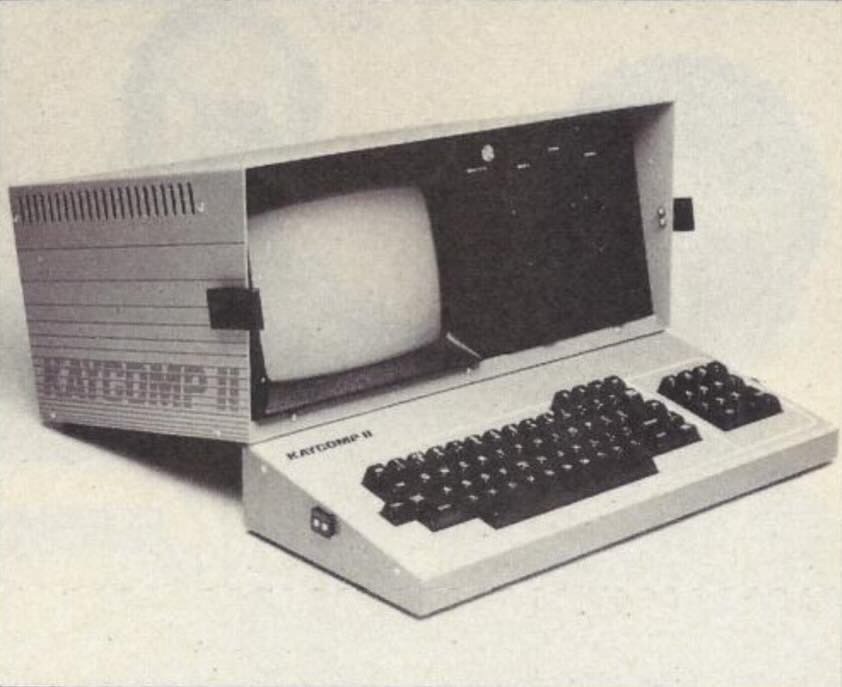
Side labeling: Kaycomp II
Back labeling: none
Keybord labeling: Kaycomp II
Brightness control: front
Floppy orientation: vertical
Floppy drives: full-high, single-sided, double density
Floppy labeling: DRIVE A, DRIVE B
Interfaces back: 1x serial, 1x parallel
Mainboard: 81-110-A
Modem: no
Real Time Clock (RTC) no
Cooling fan: no
Ventilation slots: left & right, 22 wide (each)
Ventilation slots: rear, 2x 12 wide
Mains cable: integrated
Mains switch: Alco MLSA206N (1)
Company name (back) Non-Linear Systems
Cabinet P/N: none
? = not verified due to no information/pictures
According to my information the Kaycomp II was announced in the magazines and in the dealers news but only a few were sold on the market because NLS did not have the naming rights (trademark). [3].
Currently (December 2024) I am aware of the following Kaycomp II computers (based on photo evidence):
| Serial | Label | Date | Note | Price |
|---|---|---|---|---|
| 002-561 | Kaypro II | Dec 2024 | $ xyz | |
| 002-749 | Kaycomp II | Apr 2016 | eBay | $ 125 [10] |
| 002-767 | Kaycomp II | Dec 2024 | eBay | $ 810 |
It is very curious, that there exists a Kaypro II (label on case & keyboard) with the lower serial number 002-561, see next.

Serial 2749
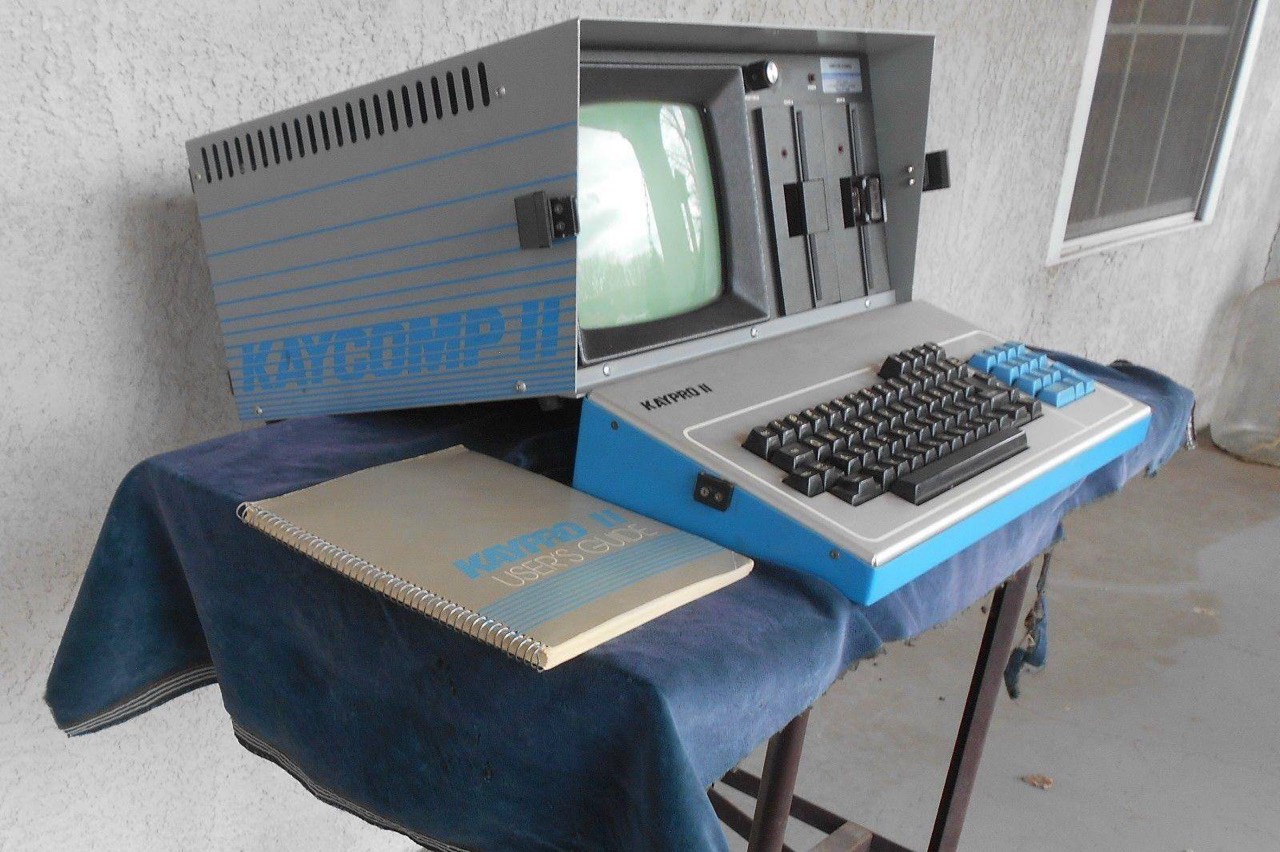
The original keyboard has been replaced.
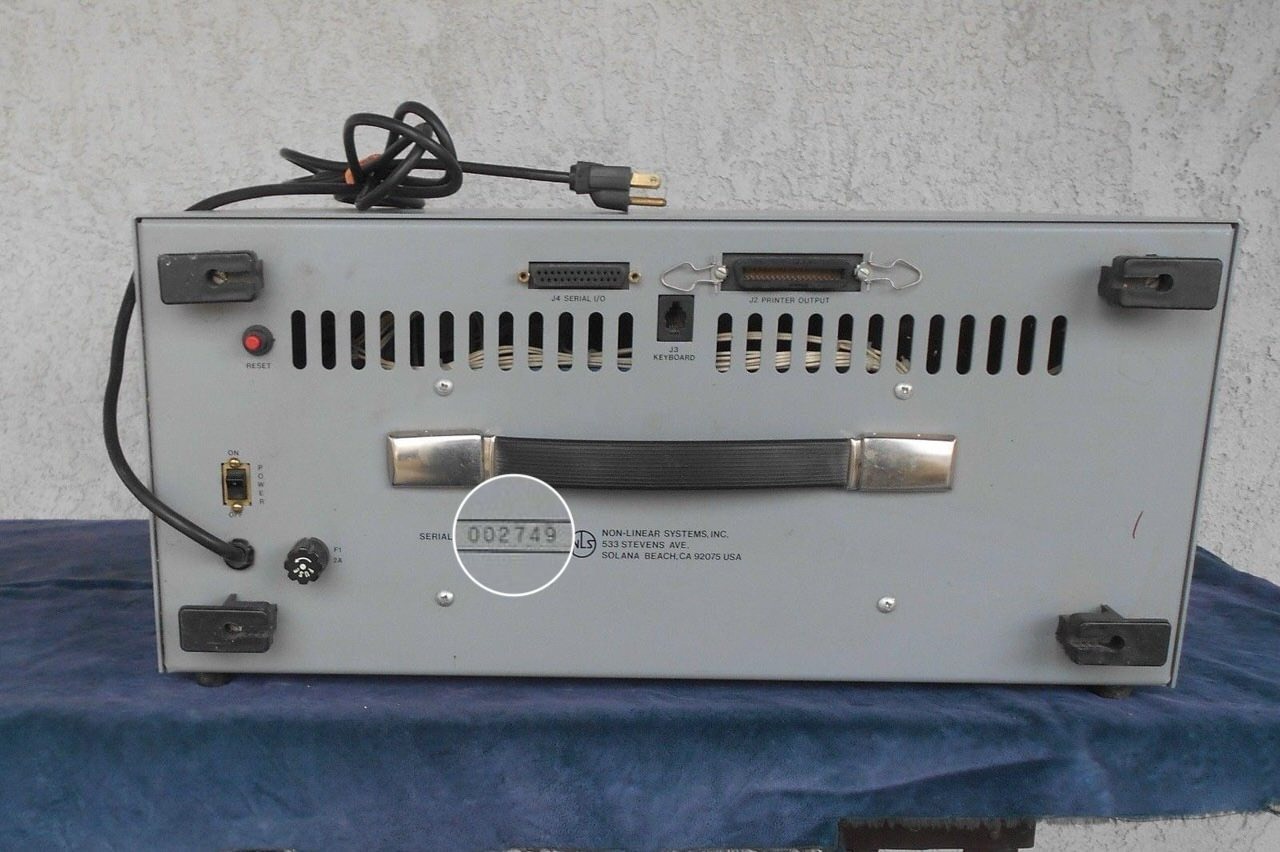
Serial 2767
Shipping
The Kaycomp II was en route from Bend (Oregon, USA) to Sarstedt (Lower Saxony, DEU) for ten days. Good things can also happen on Friday the 13th. Please do not be surprised about the pick-up date. This is the international shipping service provider in Los Angeles. The drop-off in Bend, Oregon was 3 Dec 24.
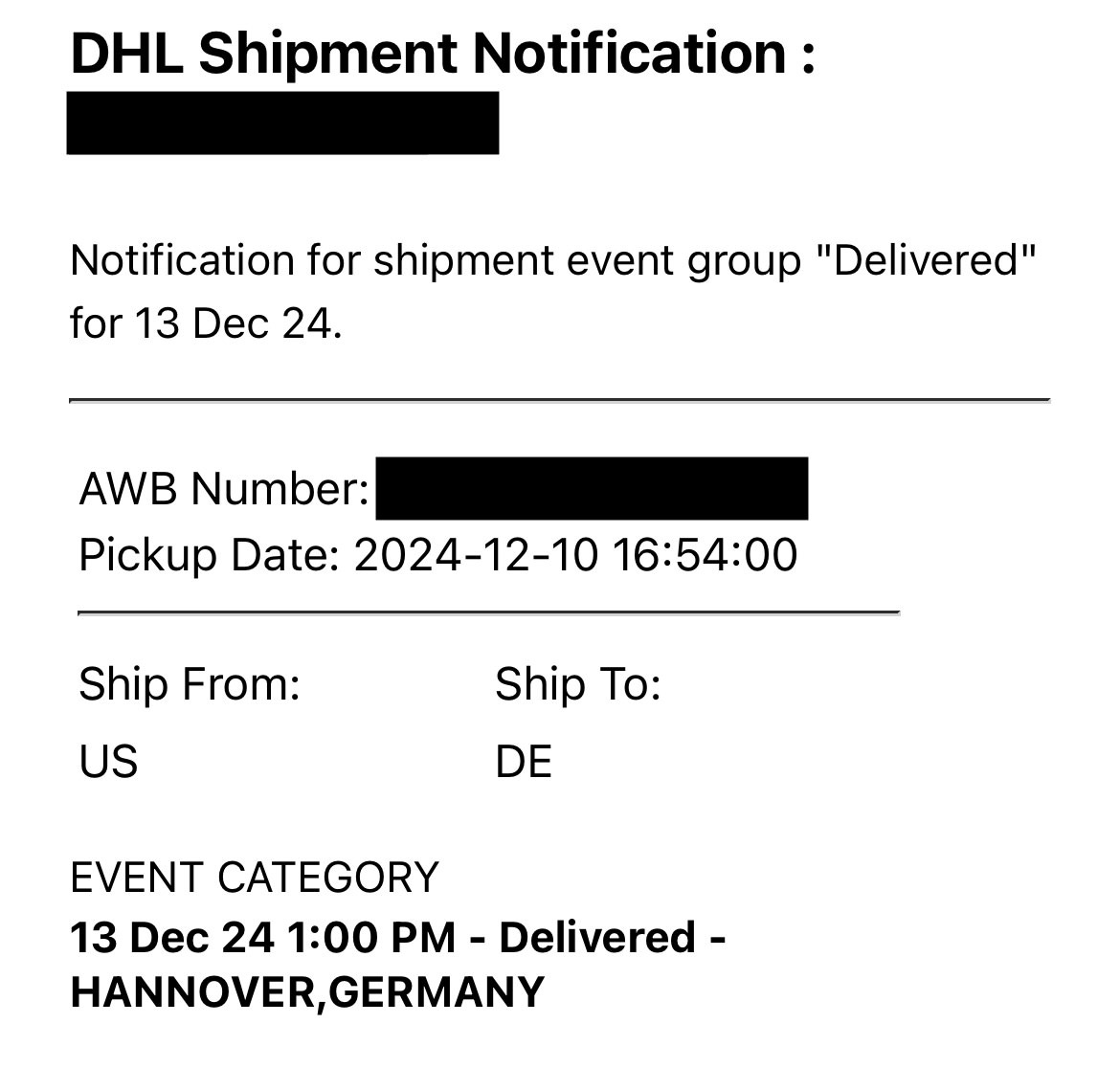
First impression
I already noticed the good external condition in the sales pictures. This impression has been confirmed, although the keyboard appears a little more used, especially on the upper edge where the Kaycomp rests. Then a quick look inside and I am even more astonished. Only two small spider threads, absolutely no dust. The CRT looks absolutely as good as new from the back. Incredible, as if the Kaycomp had never been used and had been packed almost airtight during this time. The Kaycomp has been stored (for years) in the typical Kaypro bag, which fits very well and is lightproof. Although this (brown) bag is self-made (not the original one), it has served its purpose wonderfully.
Only the six small fastening screws on the keyboard show some rust film. The housing screws are absolutely clean and without any of the other wear and tear that occurs when they are improperly screwed in and out. For the first few days, I thought it was a perfectly made fake; that's nonsense, of course. If it weren't for the keyboard, I would say the Kaycomp comes straight from the factory. I am really impressed!
The dispatch location of Bend in Oregon has a special significance. The computer journal ‘Micro Cornucopia’ by David Thompson was published from there for almost 10 years. So I imagine (for myself) that this Kaycomp once belonged to David T.
It is a fact that the Kaycomp computers were not allowed to be sold due to naming reasons. Perhaps these unsaleable units were given away to selected people. That would have been possible. And that's where this journal comes in handy. After all, test reports and the like have to be published. But that's all just speculation.
As the Kaycomp was sold by a commercial seller on behalf of a customer, I unfortunately do not have a direct contact address. However, I have asked the seller to give the customer my e-mail address with the request to get in touch with me. I can only wait and hope. ... A week has passed and I'm still waiting. It's probably not going to happen. What a pity.
Pictures
Outside

Inside
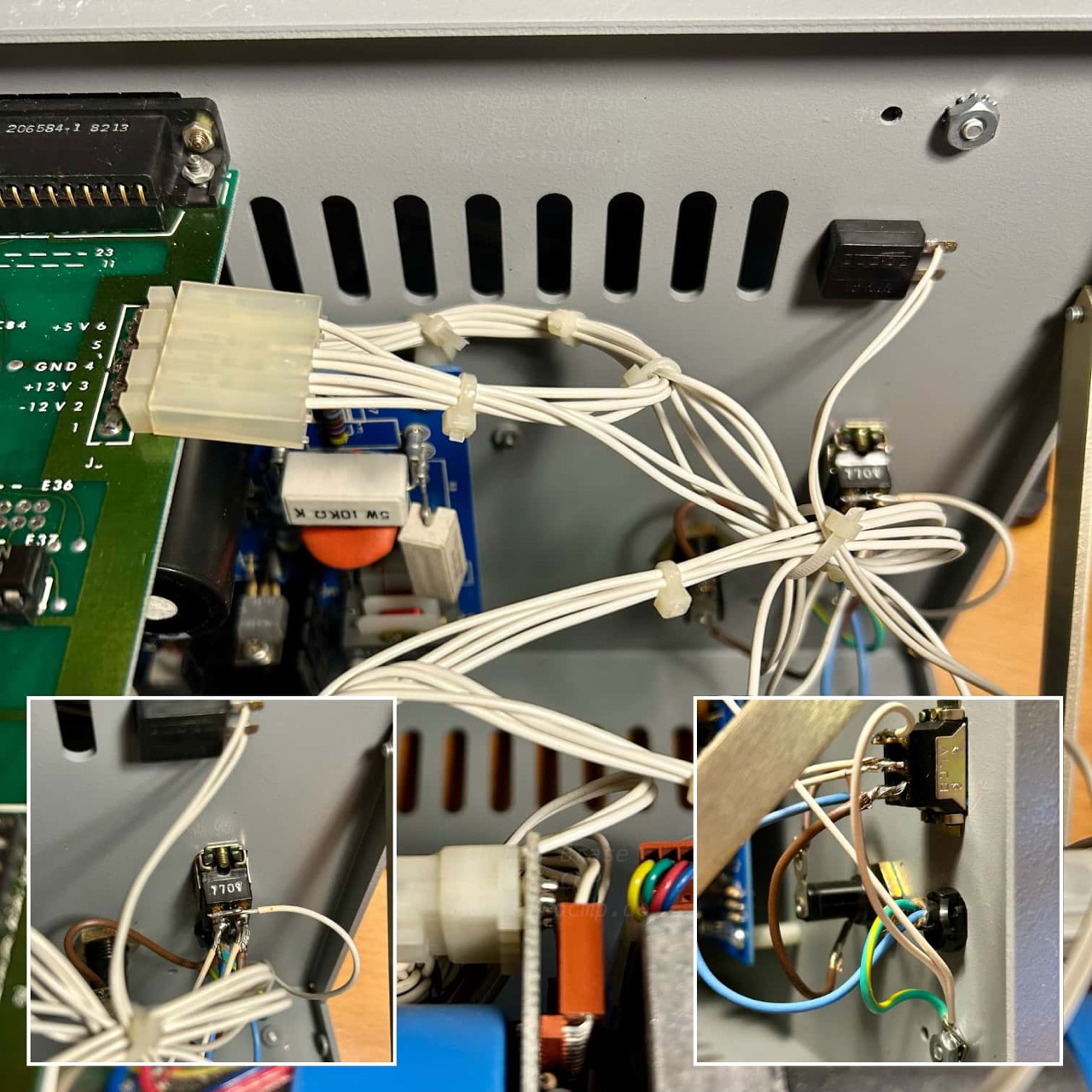
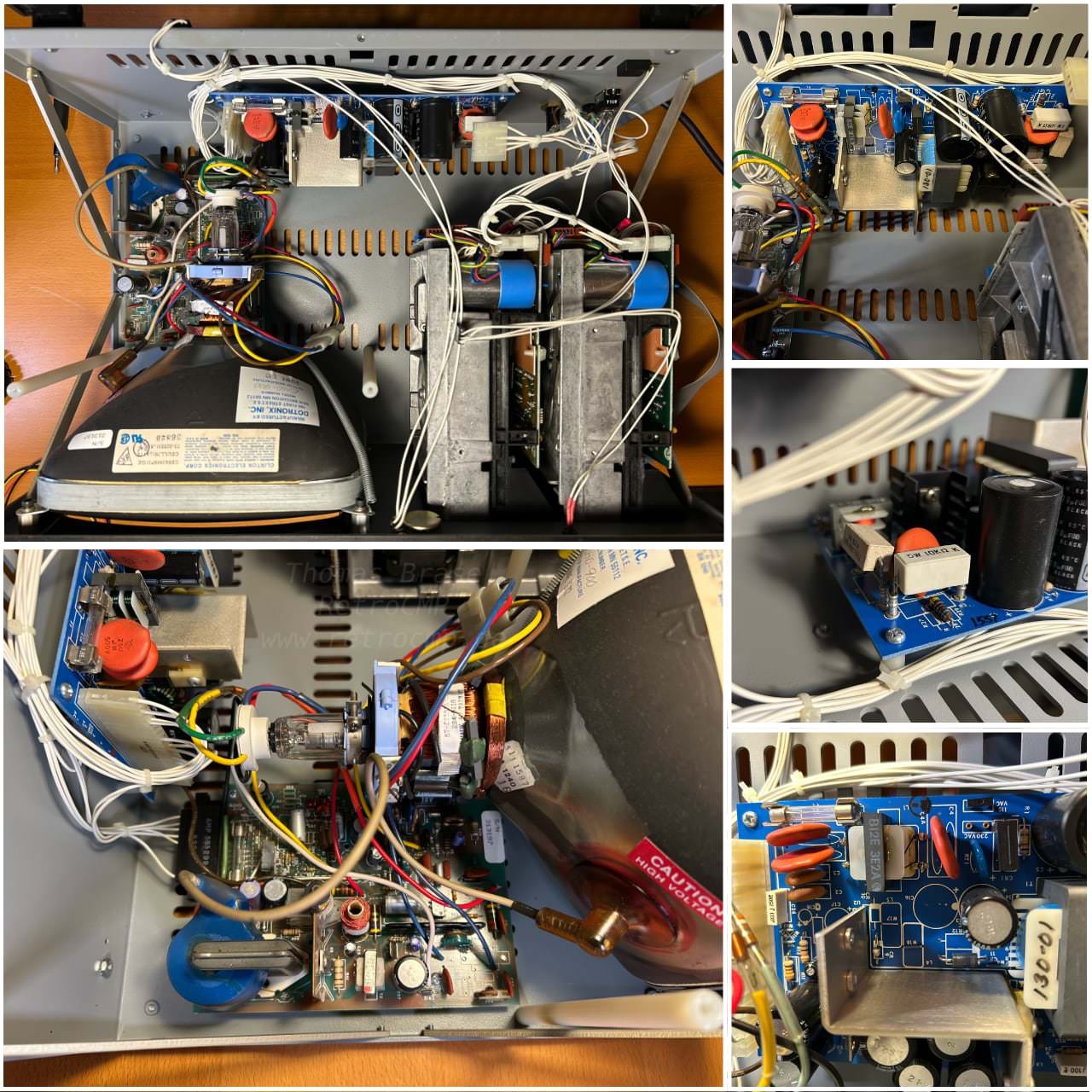
Keyboard
This Kaycomp II is currently the only complete model (with keyboard). It has the correct keyboard label, and the black number keys on the right. The Kaypro II has blue number keys. It is a Keytronic keyboard, datecode 4/82, #05440, PCB A65-02207-2O1D.
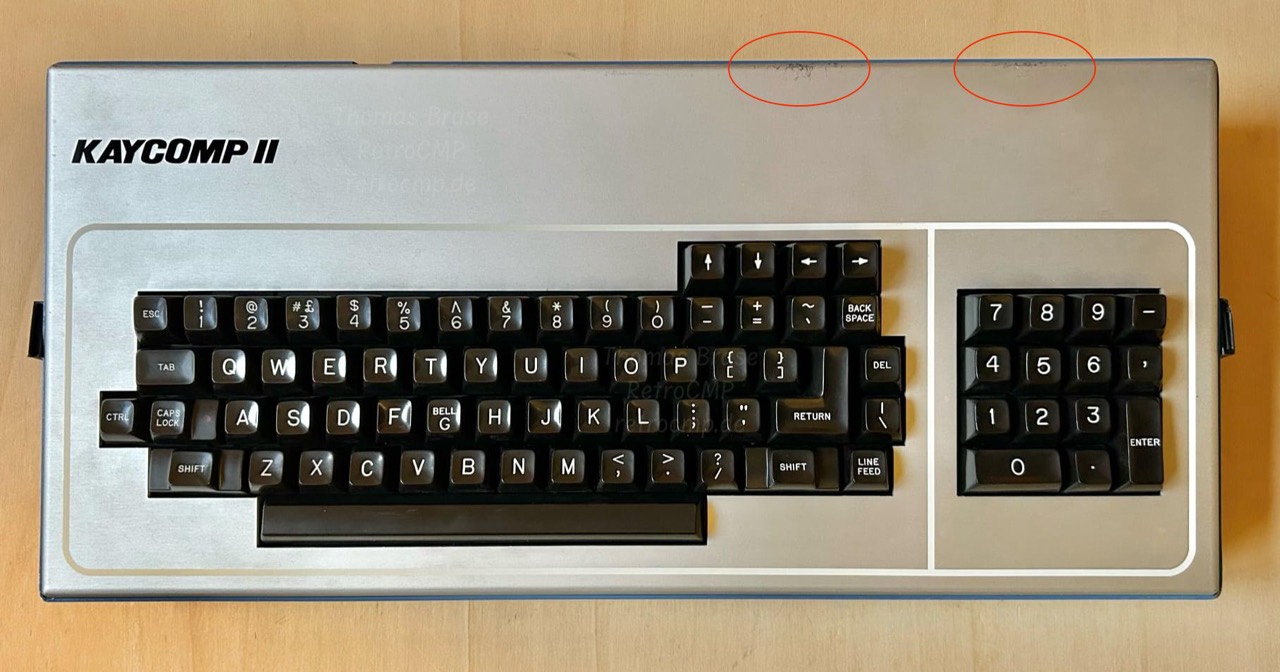
The white edging of the buttons, on the other hand, is flawless. On keyboards that are used a lot, the edges are usually rubbed away on the left and right sides of the palm.
As I mentioned at the beginning, only the screws on the keyboard were slightly rusty. However, the threads of two of them were so badly corroded that I had to drill them out. However, with the right precision drill and three different drill holes, this was no problem. The threads were not damaged and the (spare) screws (4-40, 5/16", flat head Phillips) fit again.
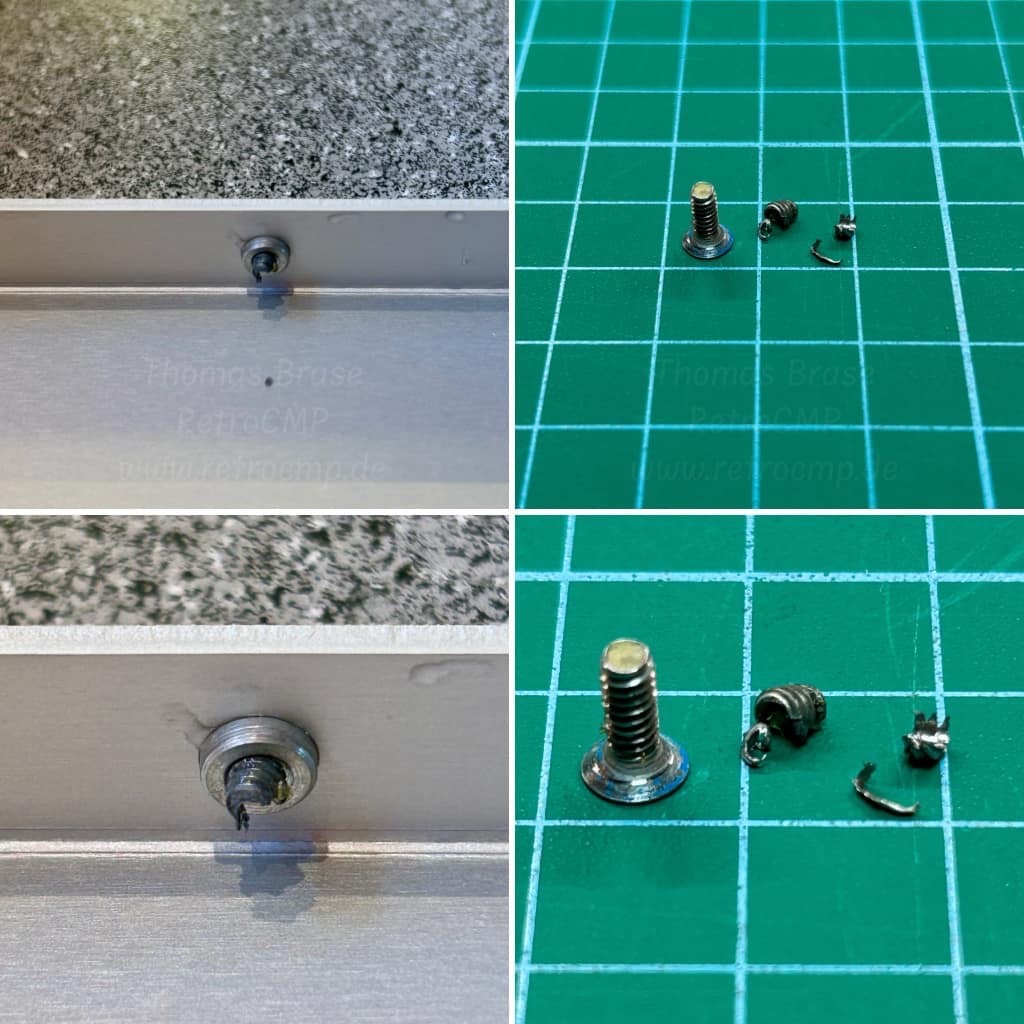
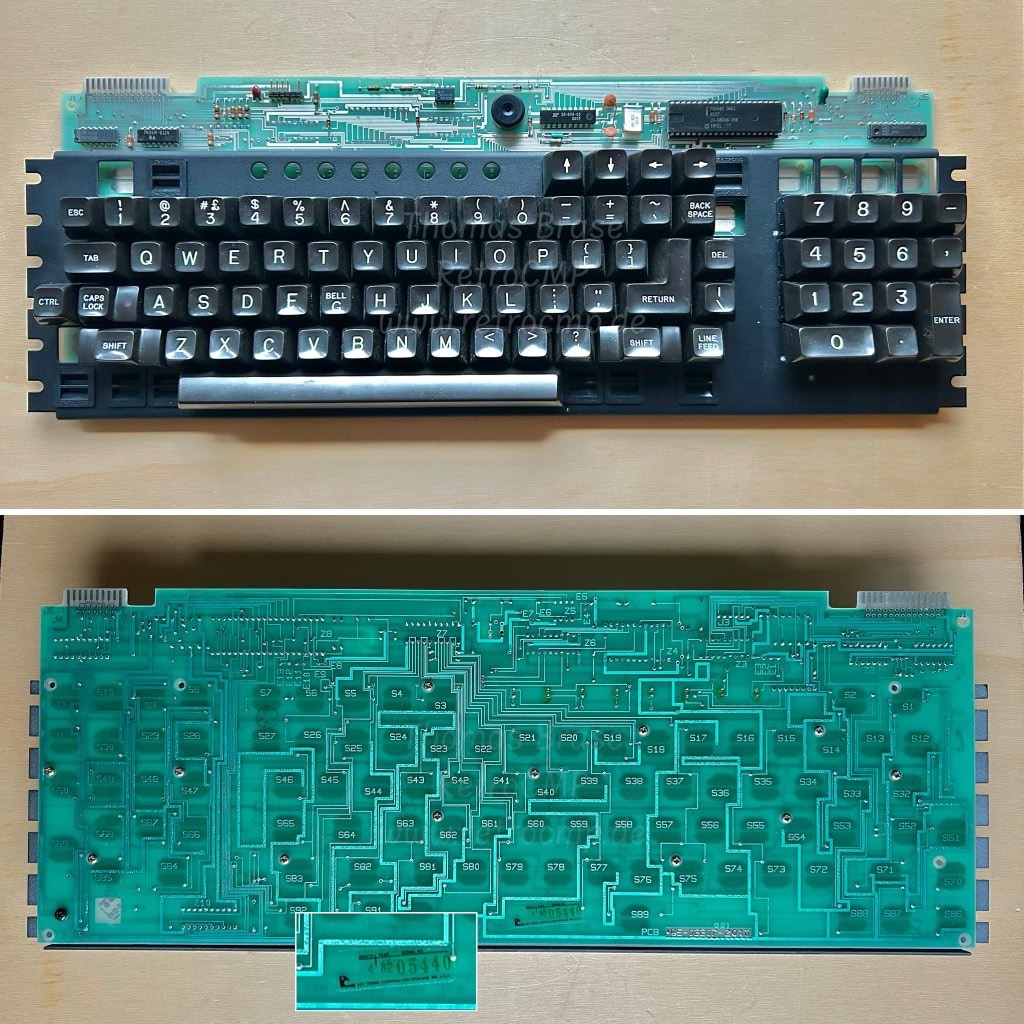
Frank Rahman's detailed collection of keyboard model pictures.
Mainboard
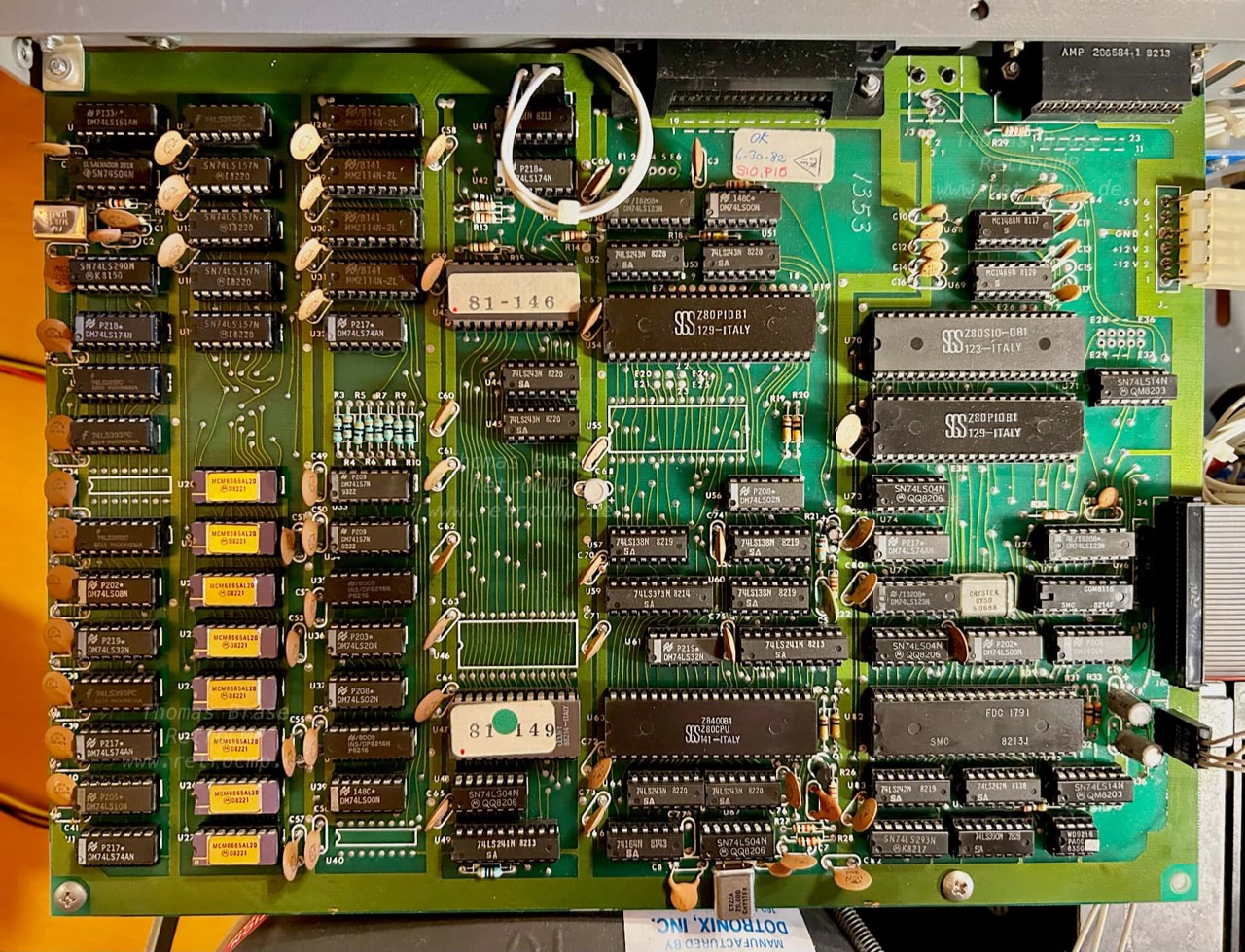
All date codes are from the 1981 and 1982. The latest ICs (U64, U65) have the code 8220 (10 May to 14 May 1982). Note: Please do not be confused by U33 and U34. Although it also says 9322, the date code is: 209, i.e. 1982, week 9! The original (but faulty) FDC9216 (U88) has the code 8214. I had to replace it. All other 81 ICs were OK. Crazy!
The DRIVE FIX and other mods are not present. The mainboard has the typical triangular NLS quality paper label which dated to 6-30-82. In other words, this mainboard was built (or quality-assured) 30 days after the first KII computer was delivered. The very first mainboards must have been manufactured before 1 June 82.
The mainboard is not shielded against the CRT & monitor board like the later Kaypro's.
CRT
ATTENTION HIGH VOLTAGE, ATTENTION RISK OF IMPLOSION AND INJURY FROM SHATTERED GLASS FLYING AROUND. I EXPRESSLY WARN YOU THAT YOUR LIFE AND/OR HEALTH IS IN DANGER IF YOU MAKE ANY CHANGES TO THE VIDEO BOARD OR THE CATHODE RAY TUBE. NEVER BRING BODY PARTS, TOOLS OR EQUIPMENT NEAR THE CATHODE RAY TUBE OR THE VIDEO BOARD. KEEP YOUR FINGERS OFF.
!!! WARNING - DANGER TO LIFE!!!
The cathode ray tube also has the correct date code: JUNE 1982. Dotronix is still on the market today (Dec 2024).
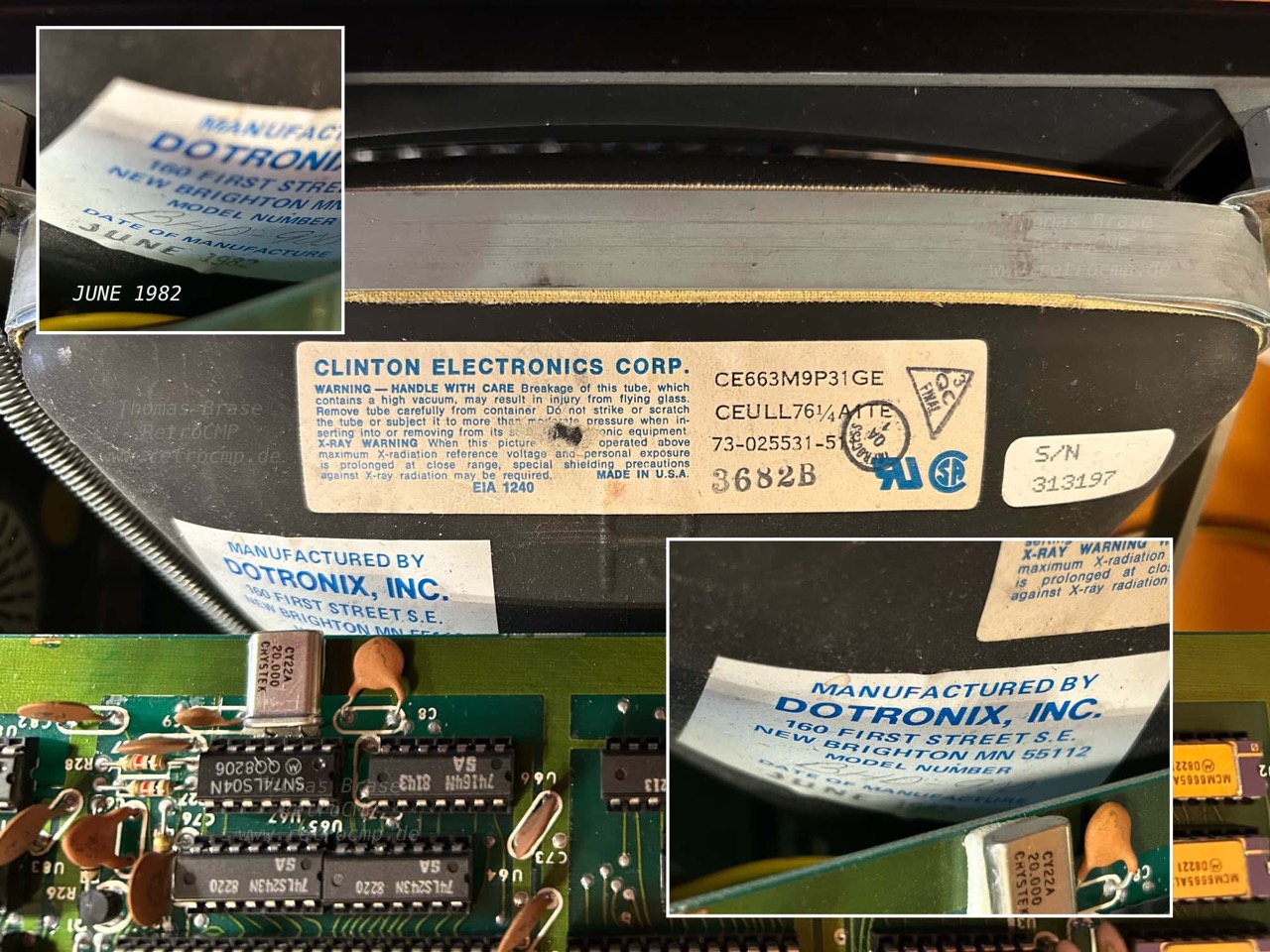
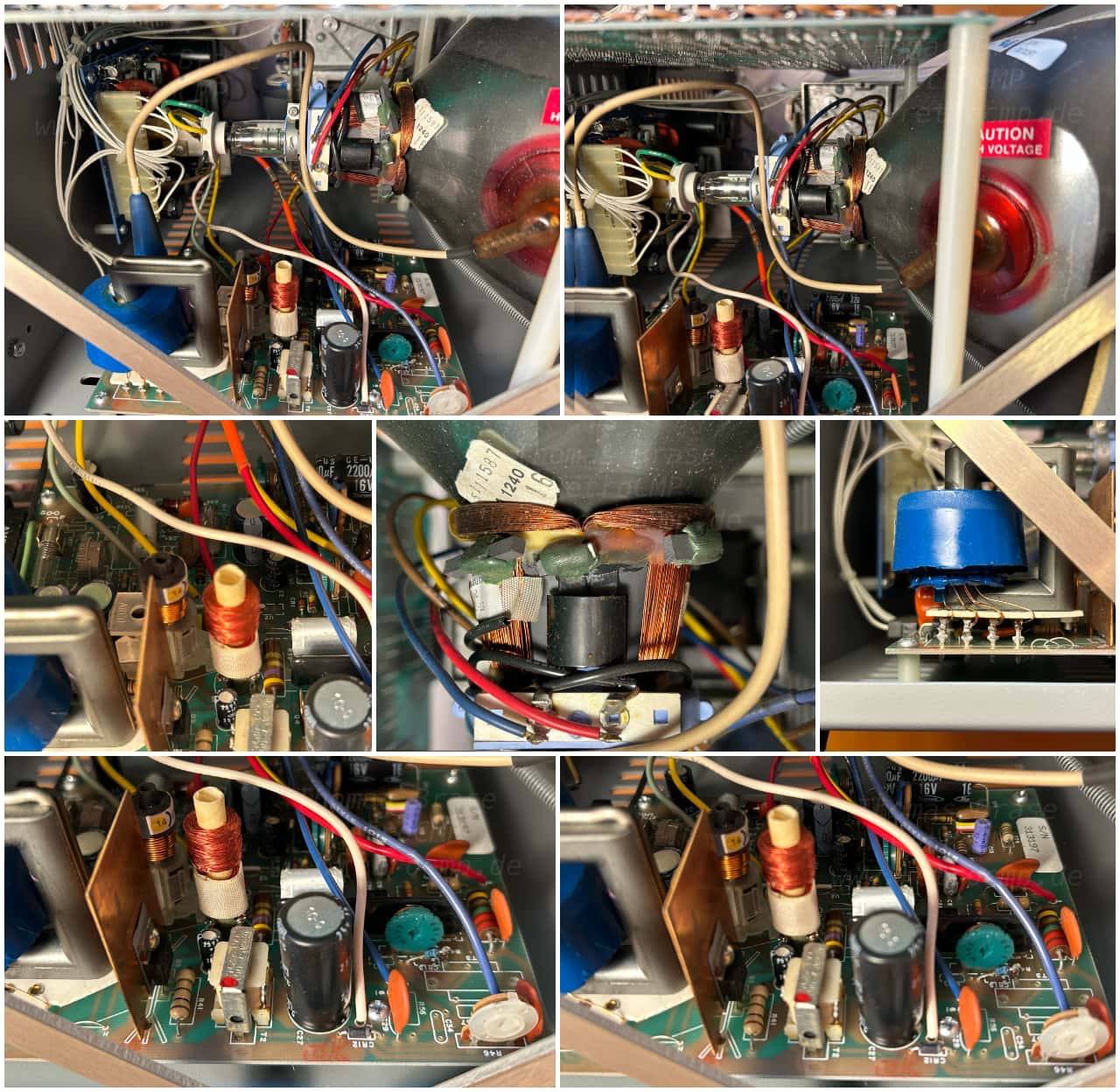
PSU & AC Cord
I AM NOT RESPONSIBLE FOR ANY LOSS, INJURY OR DAMAGE TO YOU OR YOUR PROPERTY. USE THIS INFORMATION ENTIRELY AND COMPLETELY AT YOUR OWN RISK. I MAKE NO GUARANTEES WHATSOEVER THAT ANY INFORMATION I PROVIDE IS COMPLETE, ACCURATE OR CORRECT.
!!! CAUTION DANGER TO LIFE !!!

This Kaycomp uses the blue California DC (CalDC) power supply unit. This uses ceramic disk capacitors for EMI. For this reason, I had no worries about switching on the Kaycomp and having some Rifa capacitor create smoke! Another special but negative feature of the CalDC are the two (5W) power-dissipating resistors R3 and R8 with 1K & 10K Ohm (top right). Attention, both are getting very hot (70-80 °C or 160-175 °F)! Enormous heat must have built up in the housing of the devices with this power supply unit. How could this even work without fan in summer?
With this power supply unit, it is very important that you check and adjust (R26) the voltages! I had to adjust the voltage on both my CalDC power supply units! That is very tedious. Fortunately, my variable resistor on this power supply unit was installed vertically. But it doesn't have to be that way. I have reported on this power supply unit in more detail here.
You can clearly hear a high-pitched whistling noise from this power supply unit. I can't say whether this is only the case with this one or with all CalDC PSUs. As you can see in the picture above, the AC cord is permanently connected, read next.
The oldest (and noisiest) Kaypros have an AC cord that is permanently connected the back panel (not a plug and socket). These units don't have an AC line filter (the AC wires go directly to the on/off switch). If you have one of these units, the first thing you need to do is purchase an AC line filter. You can get one that mounts on the inside of the cabinet, then you connect very short leads from the power cord to the filter. Or, even better, you can purchase a new cord and filter combination (the filter has a power socket built in). [11]
Frank Rahman's detailed collection of mains switch and PSU pictures.
Floppy Drives
The floppy disk drives are two Tandon TM 100-1A. Nothing special, they work fine.
First Tests
Booting from A: works fine, reading from B: also. Only the data separator at U88 was faulty and had to be replaced.

To Do
The only thing I will be doing with this device is the DRIVE FIX MOD at U86. This mod is fully reversible. Simply swap both ICs again and you're done.
Information
Here you will find all my gathered information about the CP/M Kaypro's.
References
- (↑) BYTE, Jul 1982, page 454
- (↑) BYTE, Jul 1982, page 171
- (↑) My conversation (video chat) with David Kay, Sep 6, 2022
- (↑) eBay sales picture
- (↑) Facebook Group: "Kaypro Computer Users"
- (↑) The Boston Kugel, Mar-Apr 1984, Volume 1, Number 4, p.1
- (↑) Kaypro Corporation, Annual Report, 1984, p.20
- (↑) David H. Rothman, The Silicon Jungle, Ballantine Books, Jul 1985
- (↑) BYTE, Jul 1982, p.171
- (↑) Frank Rahman, https://kayprojournal.com/index.php/Kaypro_2749
- (↑) Micro Cornucopia, #15, Dec 1983, page 30
- (↑) Infoworld, Dec 26 1983, page 85
- (↑) Popular Computing, Sep 1982, page 38
- (↑) San Diego Evening Tribune, May 13, 1982, page 57 (C-7)
- (↑) San Diego Evening Tribune, Sep 17, 1982, page 61 (C-8)
- (↑) Walter Salm: The Central New Jersey Home News (New Brunswick, New Jersey), Thu, Nov 24, 1983, page 99
- (↑) My conversation (email) with David Kay, Jun 2, 2025
- (↑) Electronic Engineering Times (EE Times), 15 Mar 1982, page 4
- (↑) Computer Shopper, Aug 1989, page 412
- (↑) Electronic News, Apr 19, 1982 (Frank Rahman; https://kayprojournal.com/index.php/Kaycomp_Machines; not verified by me)
- (↑) Desktop Computing, Aug 1982 (Frank Rahman; https://kayprojournal.com/index.php/Kaycomp_Machines; not verified by me)
My Series About the KAYPRO
--> Go to Part 1 : Versions
--> Go to Part 2 : Hardware
--> Go to Part 3 : 8K EPROM Modification
--> Go to Part 4 : Formatting a Hard Disk
--> Go to Part 5 : USER areas
--> Go to Part 6 : MASMENU - Master Menu
--> Go to Part 7 : Terminal
--> Go to Part 8 : KayPLUS ROM
--> Go to Part 9 : Advent TurboROM
--> Go to Part 10: Multicopy Plu*Perfect
--> Go to Part 11: Kaypro Family & Company
--> Go to Part 12: Kaypro Design Views
--> Go to Part 13: Micro Cornucopia
--> Go to Part 14: Repairing a Kaypro II
--> Go to Part 15: Kaypro Collections
--> Go to Part 16: Kaypro General
--> Go to Part 17: Kaypro Robie
--> Go to Part 18: MFM-Emulators
--> Go to Part 19: Roadrunner ROM
--> Go to Part 20: Software
--> Go to Part 21: FAQ
--> Go to Part 22: Kaypro Virtual
--> Go to Part 23: Formatting a Floppy Disk
--> Go to Part 24: ROM, EPROM
--> Go to Part 25: Kaycomp